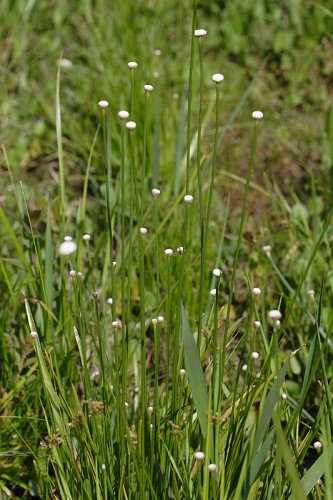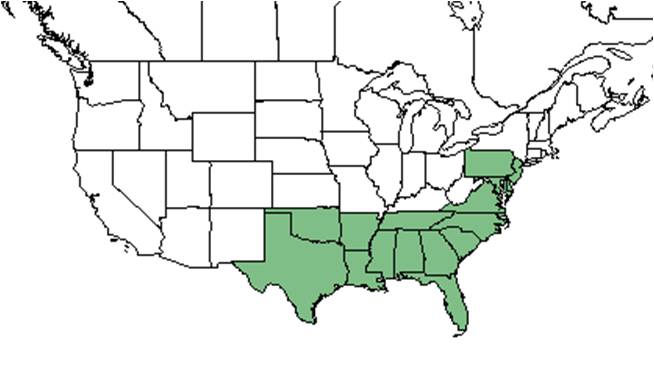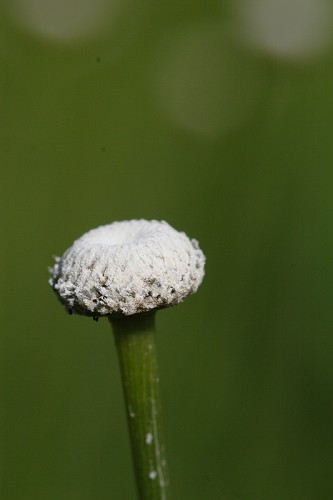Difference between revisions of "Eriocaulon decangulare"
| (30 intermediate revisions by 9 users not shown) | |||
| Line 18: | Line 18: | ||
}} | }} | ||
| − | Common name: | + | Common name: tenangle pipewort, common ten-angled pipewort, panhandle pipeword |
==Taxonomic notes== | ==Taxonomic notes== | ||
| − | + | Synonyms: none<ref name=weakley>Weakley, A.S. 2020. Flora of the Southeastern United States. Edition of 20 October 2020. University of North Carolina at Chapel Hill, Chapel Hill, North Carolina.</ref> | |
| − | + | Varieties: ''Eriocaulon decangulare'' Linnaeus ''var. decangulare''; ''Eriocaulon decangulare'' Linnaeus ''var. latifolium'' Chapman ex Moldenke<ref name=weakley/> | |
==Description== | ==Description== | ||
<!-- Basic life history facts such as annual/perrenial, monoecious/dioecious, root morphology, seed type, etc. --> | <!-- Basic life history facts such as annual/perrenial, monoecious/dioecious, root morphology, seed type, etc. --> | ||
| − | A description of ''Eriocaulon decangulare'' is provided in [http://www.efloras.org/florataxon.aspx?flora_id=1&taxon_id=220004896 The Flora of North America]. | + | A description of ''Eriocaulon decangulare'' is provided in [http://www.efloras.org/florataxon.aspx?flora_id=1&taxon_id=220004896 The Flora of North America]. Flowers of the ''Eriocaulon'' genus are arranged in a crowded head on a long and leafless stalk.<ref name= "lady bird">[[https://www.wildflower.org/plants/search.php?search_field=&newsearch=true]] Lady Bird Johnson Wildflower Center. Accessed: May 9, 2019</ref> Average maximum root depth of ''E. decangulare'' was found to be 21 cm, and average root porosity to be 71 percent.<ref>Brewer, J. S., et al. (2011). "Carnivory in plants as a beneficial trait in wetlands." Aquatic Botany 94: 62-70.</ref> |
==Distribution== | ==Distribution== | ||
| + | This species is distributed along the southeastern coastal plain from Pennsylvania and New Jersey south to Florida and west to Oklahoma and Texas.<ref name= "USDA">USDA, NRCS. (2016). The PLANTS Database (http://plants.usda.gov, 9 May 2019). National Plant Data Team, Greensboro, NC 27401-4901 USA.</ref> ''E. decangulare'' var. ''decangulare'' can be found from New Jersey south to southern Florida, west to southwest Arkansas and eastern Texas, and south into Mexico and South America. ''E. decangulare'' var. ''latifolium'' can be found only in the panhandle of Florida, southern Alabama, and southern Mississippi.<ref name=weakley/> | ||
| + | |||
==Ecology== | ==Ecology== | ||
| − | + | ||
| + | ===Habitat=== <!--Natural communities, human disturbed habitats, topography, hydrology, soils, light, fire regime requirements for removal of competition, etc.--> | ||
| + | Habitats of ''E. decangulare'' var. ''decangulare'' include wet pine flatwoods and savannas, mafic fens and seeps, bogs, wind-tidal marshes, and seasonally flooded pools. As well, ''E. decangulare'' var. ''latifolium'' can be found in seepage bogs.<ref name=weakley/> ''E. decangulare'' has been observed in a range of habitats including pond edges, in standing water of shallow ponds, moist depressions, bog muck, peaty margins, old stump hole depressions in savannas, sphagnous bogs, swampy areas, inundated pineland glades, and interdunal flats. Soils include sandy and wet soils, muck, moist to wet sandy peat, and rich loamy sand.<ref name= "herbarium">Florida State University Robert K. Godfrey Herbarium database. URL: http://herbarium.bio.fsu.edu. Last accessed: May 2019. Collectors: Frank Almeda, Loran C. Anderson, Wilson Baker, Wade Biltoft, Keith Bradley, Edwin L. Bridges, Rev. Robert Brinker, Jenny Britten, Daniel Castillo, Andre F. Clewell, R. J. Coile, George R. Cooley, A. H. Curtiss, Richard J. Eaton, Nancy Edmonson, D. L. Fichtner, Paul Fortsch, Robert K. Godfrey, Bruce Hansen, JoAnn Hansen, Gary R. Knight, R. Komarek, Mabel Kral, Robert Kral, Olga Lakela, Robert L. Lazor, Robert J Lemaire, S. W. Leonard, Sidney McDaniel, Thomas E. Miller, Marc Minno, Melanie Mitchell, Richard S. Mitchell, John B. Nelson, R. A. Norris, Steve L. Orzell, R. E. Perdue, Jr., Richard Porcher, Gwynn W. Ramsey, P. L. Redfearn, P. L. Redfearn, Jr., Grady W. Reinert, Amanda Sang, Cecil R. Slaughter, William R. Stimson, and Jean W. Wooten. States and Counties: Florida: Bay, Brevard, Broward, Calhoun, Clay, Collier, Dixie, Duval, Escambia, Franklin, Gadsden, Gulf, Hillsborough, Indian River, Jackson, Jefferson, Levy, Liberty, Madison, Manatee, Martin, Okaloosa, Orange, Osceola, Palm Beach, Santa Rosa, Sarasota, St Johns, St Lucie, Sumter, Wakulla, Walton, and Washington. Georgia: Clinch, Thomas, and Worth. South Carolina: Berkeley.</ref> The species is listed by the USDA Natural Resources Conservation Service as an obligate wetland species that is almost exclusively found in wetland habitats.<ref name= "USDA"/> It requires full sun, and has a low tolerance for calcium carbonate.<ref name= "lady bird"/> ''E. decangulare'' was found to increase its presence in response to soil disturbance by heavy silvilculture in North Carolina. It has also shown regrowth in reestablished longleaf pinelands that were disturbed by these practices.<ref>Cohen, S., R. Braham, and F. Sanchez. (2004). Seed Bank Viability in Disturbed Longleaf Pine Sites. Restoration Ecology 12(4):503-515.</ref> | ||
| + | |||
| + | Associated species include ''Pinus palustris'', ''Pinus elliottii'', ''Habenaria ciliaris'', ''Balduina uniflora'', ''Lilium catesbaei'', ''Eragrostis elliottii'', ''Rhynchospora'' sp., ''Cyrilla racemiflora'', ''Taxodium'' sp., ''Aristida tussocks'', ''Ilex coriacea'', ''Lobelia brevifolia'', ''Lobelia nuttallii'', ''Polygala brevifolia'', ''Polygala ramosa'', ''Polygala lutea'', ''Pluchea baccharis'', ''Sarracenia flava'', ''Rhexia petiolata'', ''Lycopodium carolinianum'', and ''Utricularia juncea''.<ref name= "herbarium"/> | ||
| + | |||
| + | ''Eriocaulon decangulare'' is frequent and abundant in the North Florida Wet Flatlands, Lower Panhandle Savannas, and Panhandle Seepage Savannas community types as described in Carr et al. (2010).<ref>Carr, S.C., K.M. Robertson, and R.K. Peet. 2010. A vegetation classification of fire-dependent pinelands of Florida. Castanea 75:153-189.</ref> | ||
| + | |||
===Phenology=== <!--Timing off flowering, fruiting, seed dispersal, and environmental triggers. Cite PanFlora website if appropriate: http://www.gilnelson.com/PanFlora/ --> | ===Phenology=== <!--Timing off flowering, fruiting, seed dispersal, and environmental triggers. Cite PanFlora website if appropriate: http://www.gilnelson.com/PanFlora/ --> | ||
| − | ''E. decangulare'' has been observed flowering in January and also from March to November with peak inflorescence in June.<ref>Nelson, G. [http://www.gilnelson.com/ PanFlora]: Plant data for the eastern United States with emphasis on the Southeastern Coastal Plains, Florida, and the Florida Panhandle. www.gilnelson.com/PanFlora/ Accessed: 9 DEC 2016</ref> | + | Generally, ''E. decangulare'' flowers from June until October.<ref name=weakley/> It has been observed flowering in January and also from March to November with peak inflorescence in June.<ref>Nelson, G. [http://www.gilnelson.com/ PanFlora]: Plant data for the eastern United States with emphasis on the Southeastern Coastal Plains, Florida, and the Florida Panhandle. www.gilnelson.com/PanFlora/ Accessed: 9 DEC 2016</ref><ref name= "herbarium"/> |
<!--===Seed dispersal===--> | <!--===Seed dispersal===--> | ||
| − | |||
| − | |||
| − | === | + | ===Seed bank and germination=== |
| − | + | This species has been found in the seed bank of both disturbed and non-disturbed areas in its native habitat.<ref>Cohen, S., et al. (2004). "Seed bank viability in disturbed longleaf pine sites." Restoration Ecology 12: 503-515.</ref> | |
| − | + | ===Fire ecology=== <!--Fire tolerance, fire dependence, adaptive fire responses--> | |
| + | It is commonly found in habitats that are fire-dependent.<ref>Carr, S. C., et al. (2010). "A Vegetation Classification of Fire-Dependent Pinelands of Florida." Castanea 75(2): 153-189.</ref> | ||
| − | Halictidae | + | ===Pollination=== |
| + | ''Eriocaulon decangulare'' has been observed at the Archbold Biological Station to host plasterer bees such as ''Hylaeus confluens'' (family Colletidae), leafcutting bees such as ''Megachile albitarsis'' (family Megachilidae), sweat bees from the Halictidae family such as ''Halictus poeyi, Lasioglossum coreopsis, L. nymphalis'' and ''L. tamiamensis'', wasps from the Vespidae family such as ''Pachodynerus erynnis, Stenodynerus fundatiformis'' and ''S. histrionalis rufustus'', thread-waisted wasps from the Sphecidae family such as ''Cerceris blakei, Ectemnius rufipes ais'' and ''Philanthus ventilabris''.<ref name="Deyrup 2015">Deyrup, M.A. and N.D. 2015. Database of observations of Hymenoptera visitations to flowers of plants on Archbold Biological Station, Florida, USA.</ref> Other species in the Hymenoptera order seen to pollinate ''E. decangulare'' include ''Dialictus coreopsis'', ''Dialictus tamiamensis'', and ''Halictus ligatus''.<ref>Deyrup, M. J. E., and Beth Norden (2002). "The diversity and floral hosts of bees at the Archbold Biological Station, Florida (Hymenoptera: Apoidea)." Insecta mundi 16(1-3).</ref> Additionally, ''E. decangulare'' has been observed to host owlflies such as ''Ululodes quadripunctatus'' (family Ascalaphidae).<ref>Discoverlife.org [https://www.discoverlife.org/20/q?search=Bidens+albaDiscoverlife.org|Discoverlife.org]</ref> | ||
| − | + | <!--===Herbivory and toxicology===--> | |
| + | <!--===Diseases and parasites===--> | ||
| − | + | ==Conservation, cultivation, and restoration== | |
| − | + | This species is listed as extirpated by the Pennsylvania Department of Conservation and Natural Resources, and it is listed as endangered by the Tennessee Department of Environment and Conservation, Natural Heritage Program.<ref name= "USDA"/> | |
| − | |||
| − | |||
| − | < | ||
| − | == | + | ==Cultural use== |
| − | |||
==Photo Gallery== | ==Photo Gallery== | ||
<gallery widths=180px> | <gallery widths=180px> | ||
Latest revision as of 14:08, 26 May 2023
| Eriocaulon decangulare | |
|---|---|

| |
| Photo by John R. Gwaltney, Southeastern Flora.com | |
| Scientific classification | |
| Kingdom: | Plantae |
| Division: | Magnoliophyta - Flowering plants |
| Class: | Liliopsida – Monocotyledons |
| Order: | Eriocaulales |
| Family: | Eriocaulaceae |
| Genus: | Eriocaulon |
| Species: | E. decangulare |
| Binomial name | |
| Eriocaulon decangulare L. | |

| |
| Natural range of Eriocaulon decangulare from USDA NRCS Plants Database. | |
Common name: tenangle pipewort, common ten-angled pipewort, panhandle pipeword
Contents
Taxonomic notes
Synonyms: none[1]
Varieties: Eriocaulon decangulare Linnaeus var. decangulare; Eriocaulon decangulare Linnaeus var. latifolium Chapman ex Moldenke[1]
Description
A description of Eriocaulon decangulare is provided in The Flora of North America. Flowers of the Eriocaulon genus are arranged in a crowded head on a long and leafless stalk.[2] Average maximum root depth of E. decangulare was found to be 21 cm, and average root porosity to be 71 percent.[3]
Distribution
This species is distributed along the southeastern coastal plain from Pennsylvania and New Jersey south to Florida and west to Oklahoma and Texas.[4] E. decangulare var. decangulare can be found from New Jersey south to southern Florida, west to southwest Arkansas and eastern Texas, and south into Mexico and South America. E. decangulare var. latifolium can be found only in the panhandle of Florida, southern Alabama, and southern Mississippi.[1]
Ecology
Habitat
Habitats of E. decangulare var. decangulare include wet pine flatwoods and savannas, mafic fens and seeps, bogs, wind-tidal marshes, and seasonally flooded pools. As well, E. decangulare var. latifolium can be found in seepage bogs.[1] E. decangulare has been observed in a range of habitats including pond edges, in standing water of shallow ponds, moist depressions, bog muck, peaty margins, old stump hole depressions in savannas, sphagnous bogs, swampy areas, inundated pineland glades, and interdunal flats. Soils include sandy and wet soils, muck, moist to wet sandy peat, and rich loamy sand.[5] The species is listed by the USDA Natural Resources Conservation Service as an obligate wetland species that is almost exclusively found in wetland habitats.[4] It requires full sun, and has a low tolerance for calcium carbonate.[2] E. decangulare was found to increase its presence in response to soil disturbance by heavy silvilculture in North Carolina. It has also shown regrowth in reestablished longleaf pinelands that were disturbed by these practices.[6]
Associated species include Pinus palustris, Pinus elliottii, Habenaria ciliaris, Balduina uniflora, Lilium catesbaei, Eragrostis elliottii, Rhynchospora sp., Cyrilla racemiflora, Taxodium sp., Aristida tussocks, Ilex coriacea, Lobelia brevifolia, Lobelia nuttallii, Polygala brevifolia, Polygala ramosa, Polygala lutea, Pluchea baccharis, Sarracenia flava, Rhexia petiolata, Lycopodium carolinianum, and Utricularia juncea.[5]
Eriocaulon decangulare is frequent and abundant in the North Florida Wet Flatlands, Lower Panhandle Savannas, and Panhandle Seepage Savannas community types as described in Carr et al. (2010).[7]
Phenology
Generally, E. decangulare flowers from June until October.[1] It has been observed flowering in January and also from March to November with peak inflorescence in June.[8][5]
Seed bank and germination
This species has been found in the seed bank of both disturbed and non-disturbed areas in its native habitat.[9]
Fire ecology
It is commonly found in habitats that are fire-dependent.[10]
Pollination
Eriocaulon decangulare has been observed at the Archbold Biological Station to host plasterer bees such as Hylaeus confluens (family Colletidae), leafcutting bees such as Megachile albitarsis (family Megachilidae), sweat bees from the Halictidae family such as Halictus poeyi, Lasioglossum coreopsis, L. nymphalis and L. tamiamensis, wasps from the Vespidae family such as Pachodynerus erynnis, Stenodynerus fundatiformis and S. histrionalis rufustus, thread-waisted wasps from the Sphecidae family such as Cerceris blakei, Ectemnius rufipes ais and Philanthus ventilabris.[11] Other species in the Hymenoptera order seen to pollinate E. decangulare include Dialictus coreopsis, Dialictus tamiamensis, and Halictus ligatus.[12] Additionally, E. decangulare has been observed to host owlflies such as Ululodes quadripunctatus (family Ascalaphidae).[13]
Conservation, cultivation, and restoration
This species is listed as extirpated by the Pennsylvania Department of Conservation and Natural Resources, and it is listed as endangered by the Tennessee Department of Environment and Conservation, Natural Heritage Program.[4]
Cultural use
Photo Gallery
Eriocaulon decangulare Photo by John R. Gwaltney, Southeastern Flora.com
References and notes
- ↑ 1.0 1.1 1.2 1.3 1.4 Weakley, A.S. 2020. Flora of the Southeastern United States. Edition of 20 October 2020. University of North Carolina at Chapel Hill, Chapel Hill, North Carolina.
- ↑ 2.0 2.1 [[1]] Lady Bird Johnson Wildflower Center. Accessed: May 9, 2019
- ↑ Brewer, J. S., et al. (2011). "Carnivory in plants as a beneficial trait in wetlands." Aquatic Botany 94: 62-70.
- ↑ 4.0 4.1 4.2 USDA, NRCS. (2016). The PLANTS Database (http://plants.usda.gov, 9 May 2019). National Plant Data Team, Greensboro, NC 27401-4901 USA.
- ↑ 5.0 5.1 5.2 Florida State University Robert K. Godfrey Herbarium database. URL: http://herbarium.bio.fsu.edu. Last accessed: May 2019. Collectors: Frank Almeda, Loran C. Anderson, Wilson Baker, Wade Biltoft, Keith Bradley, Edwin L. Bridges, Rev. Robert Brinker, Jenny Britten, Daniel Castillo, Andre F. Clewell, R. J. Coile, George R. Cooley, A. H. Curtiss, Richard J. Eaton, Nancy Edmonson, D. L. Fichtner, Paul Fortsch, Robert K. Godfrey, Bruce Hansen, JoAnn Hansen, Gary R. Knight, R. Komarek, Mabel Kral, Robert Kral, Olga Lakela, Robert L. Lazor, Robert J Lemaire, S. W. Leonard, Sidney McDaniel, Thomas E. Miller, Marc Minno, Melanie Mitchell, Richard S. Mitchell, John B. Nelson, R. A. Norris, Steve L. Orzell, R. E. Perdue, Jr., Richard Porcher, Gwynn W. Ramsey, P. L. Redfearn, P. L. Redfearn, Jr., Grady W. Reinert, Amanda Sang, Cecil R. Slaughter, William R. Stimson, and Jean W. Wooten. States and Counties: Florida: Bay, Brevard, Broward, Calhoun, Clay, Collier, Dixie, Duval, Escambia, Franklin, Gadsden, Gulf, Hillsborough, Indian River, Jackson, Jefferson, Levy, Liberty, Madison, Manatee, Martin, Okaloosa, Orange, Osceola, Palm Beach, Santa Rosa, Sarasota, St Johns, St Lucie, Sumter, Wakulla, Walton, and Washington. Georgia: Clinch, Thomas, and Worth. South Carolina: Berkeley.
- ↑ Cohen, S., R. Braham, and F. Sanchez. (2004). Seed Bank Viability in Disturbed Longleaf Pine Sites. Restoration Ecology 12(4):503-515.
- ↑ Carr, S.C., K.M. Robertson, and R.K. Peet. 2010. A vegetation classification of fire-dependent pinelands of Florida. Castanea 75:153-189.
- ↑ Nelson, G. PanFlora: Plant data for the eastern United States with emphasis on the Southeastern Coastal Plains, Florida, and the Florida Panhandle. www.gilnelson.com/PanFlora/ Accessed: 9 DEC 2016
- ↑ Cohen, S., et al. (2004). "Seed bank viability in disturbed longleaf pine sites." Restoration Ecology 12: 503-515.
- ↑ Carr, S. C., et al. (2010). "A Vegetation Classification of Fire-Dependent Pinelands of Florida." Castanea 75(2): 153-189.
- ↑ Deyrup, M.A. and N.D. 2015. Database of observations of Hymenoptera visitations to flowers of plants on Archbold Biological Station, Florida, USA.
- ↑ Deyrup, M. J. E., and Beth Norden (2002). "The diversity and floral hosts of bees at the Archbold Biological Station, Florida (Hymenoptera: Apoidea)." Insecta mundi 16(1-3).
- ↑ Discoverlife.org [2]
